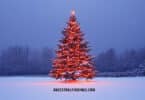The sound of sleigh bells jingling through the crisp winter air evokes images of joyful gatherings, festive decorations, and cherished family traditions. But how can you uncover the specific ways your ancestors celebrated the holidays? Often overlooked in genealogical research, census records hold valuable insights that illuminate your family’s holiday history, revealing traditions, lifestyles, and community connections that shaped their Christmases long before your own traditions took root.
Understanding Census Records
Census records are snapshots of a family’s life at specific points in time, typically collected every ten years. They provide essential details such as names, ages, occupations, places of birth, and relationships within the household. Beyond these basics, census records can offer subtle hints about how families spent their holidays.
For example, information about a household’s size, economic status, and occupation can help you infer the holiday activities they might have engaged in. A family with multiple children and a stable occupation might have had more elaborate celebrations. In contrast, a smaller family or one facing economic hardships might have focused on more straightforward, more intimate gatherings.
What to Look For
When examining census records for holiday history, pay attention to the following:
1. Household Composition: A large household with extended family members might indicate gatherings that included aunts, uncles, and cousins, fostering rich holiday traditions.
2. Occupations: Your ancestors’ work can influence their holiday practices. Farmers might have celebrated with outdoor activities, while artisans could have made decorations or gifts.
3. Place of Birth and Immigration Status: Understanding where your ancestors came from can help you trace the cultural traditions they brought with them. Immigrants might have blended their native customs with their new homeland, creating unique holiday practices.
4. Education Levels: Higher education levels might correlate with holiday celebrations, such as attending community events or engaging in philanthropic activities.
5. Marital Status and Ages: Information about spouse’s and family members’ ages can provide context for the dynamics of holiday gatherings, such as whether grandparents lived with the family and participated in celebrations.
Incorporating Personal Memories
Reflecting on personal family memories can enhance your interpretation of census data. For instance, I remember when my parents and grandparents would say, “Squint your eyes when you look at the Christmas tree; you can see the lights better.” This simple instruction created a magical moment, turning ordinary lights into shimmering halos and adding a touch of wonder to our holiday decorations.
When researching your family’s holiday history, consider how such memories might connect to the information found in census records. Perhaps a large household size revealed in a census correlates with memories of big family gatherings, where traditions like squinting at the tree lights were shared among many relatives. These personal touches bridge the gap between the numbers on a page and the lived experiences of your ancestors, making their holiday celebrations feel more tangible and relatable.
Interpreting Data
Interpreting census data requires a bit of detective work and contextual understanding. Here’s how to make sense of the information:
• Economic Indicators: Look for signs of prosperity or hardship. A prosperous family might afford decorative trees, special foods, and gifts, while a family facing economic challenges might prioritize homemade decorations and shared meals over costly gifts.
• Geographical Clues: The region where your ancestors lived can offer insights into their holiday activities. Coastal families might have included seafood in their holiday feasts, while those in mountainous areas could have engaged in skiing or ice skating as part of their celebrations.
• Community Involvement: Information about neighbors or community roles can hint at collective holiday events. Families in their community might have participated in local parades, church events, or neighborhood gift exchanges.
Linking to Traditions
Once you’ve gathered and interpreted the relevant data from census records, the next step is to link these insights to specific holiday traditions. Here are some ways to make those connections:
1. Compare with Family Stories: Align the information from census records with oral histories or written family stories. If a census record shows a large household, compare it with family anecdotes about big holiday gatherings.
2. Research Regional Traditions: Investigate the common holiday practices in the regions where your ancestors lived. This can help you understand the cultural context of their celebrations and identify any unique practices your family may have had.
3. Identify Ancestral Occupations and Skills: If your ancestors were skilled artisans, they might have crafted their decorations or gifts. Farmers could have included homemade preserves or baked goods in their holiday feasts.
4. Consider Religious and Cultural Influences: Religion often plays a significant role in holiday traditions. Understanding your ancestors’ religious affiliations can help explain the rituals and ceremonies they observed during the holidays.
Tips for Researching Holiday History Through Census Records
• Start with Detailed Searches: Use specific search terms related to your ancestors’ names, occupations, and places of residence to find relevant census records. Online databases like Ancestry.com, FamilySearch.org, and MyHeritage.com can be invaluable resources.
• Utilize Additional Resources: Supplement census data with other records such as diaries, letters, photographs, and newspaper articles. These can provide more nuanced insights into holiday celebrations.
• Join Genealogy Groups: Engage with online forums or local genealogy societies. Sharing information and collaborating with others can uncover new perspectives and resources for your research.
• Document Your Findings: Keep detailed notes of your discoveries, including the context and potential connections to holiday traditions. This will help you comprehensively picture your family’s holiday history.
• Be Patient and Persistent: Genealogical research can be time-consuming and sometimes frustrating, but the rewards of uncovering your family’s holiday traditions are well worth the effort.
Bringing It All Together
Imagine uncovering a census record from the 1920s that shows your great-grandparents lived in a bustling urban neighborhood with several extended family members. Combined with family stories about hosting large holiday dinners and exchanging handmade gifts, you can begin to recreate those traditions today. Perhaps you find an old recipe in a family cookbook that traces back to that era, or you decide to host a gathering that mirrors the one your ancestors cherished.
Using census records to research your family’s holiday history, you better understand the traditions that have shaped your celebrations. These records don’t just tell you where and when your ancestors lived—they help you see how they celebrated, what they valued, and how they created memories that have been passed down through generations.
As you decorate your tree, prepare your favorite holiday dishes, or exchange gifts, take a moment to reflect on the legacy of your ancestors. Each ornament, each recipe, and each shared story is a link in the chain of your family’s holiday heritage. By honoring these connections, you not only celebrate the season but also pay tribute to the generations that came before you, ensuring that their traditions continue to bring joy and meaning to your Christmas celebrations.






